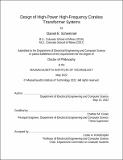| dc.description.abstract | This thesis concerns advances in the design of coreless power transformers as well as associated power electronics, which can also add extra functionality. Compared to traditional core-based transformers that require large, heavy and costly magnetic cores to guide magnetic flux between windings, the coreless power transformer employs extra resonant coils to provide near perfect magnetic coupling between input and output windings. The four-coil implementation of a high-frequency coreless power transformer was recently introduced along with basic analysis and a 100 W working demonstration device. While the development of this new coreless transformer was a significant achievement, a number of issues remain for it to be practical in electric grid applications. A key topic addressed is a means to optimize the design as well as establishing a universal metric that quantifies coreless transformer performance. Other topics include the integration of the transformer as a component of a larger system through the development of required power electronics to drive the transformer and magnetic shielding to provide control of external magnetic fields. The overall objective of this thesis is to provide guidance on the design of coreless transformer systems and to extend coreless transformer technology to higher powers.
More specifically, through the design and construction of different four-coil coreless transformers, topics associated with the system level design of coreless transformers are addressed in the context of DC-to-DC systems. This includes the design, construction, and testing of three transformers with ratings of 1 kW at 150 kHz, 1 kW at 300 kHz, and 40 kW at 300 kHz. Efficiencies of these transformers ranged from about 93% to over 98%. A new design algorithm based on particle swarm optimization is applied to optimize the required 21 parameters in the transformer design space. An important metric for the optimization process is shown to be the transformer S₂₁ scattering parameter. This work also includes implementation of a suitable H-bridge inverter with zero-voltage switching and full-bridge rectification to produce a DC output. In addition, topics such as compensation, magnetic shielding, and transformer stacking with synchronization are presented in detail. | |
